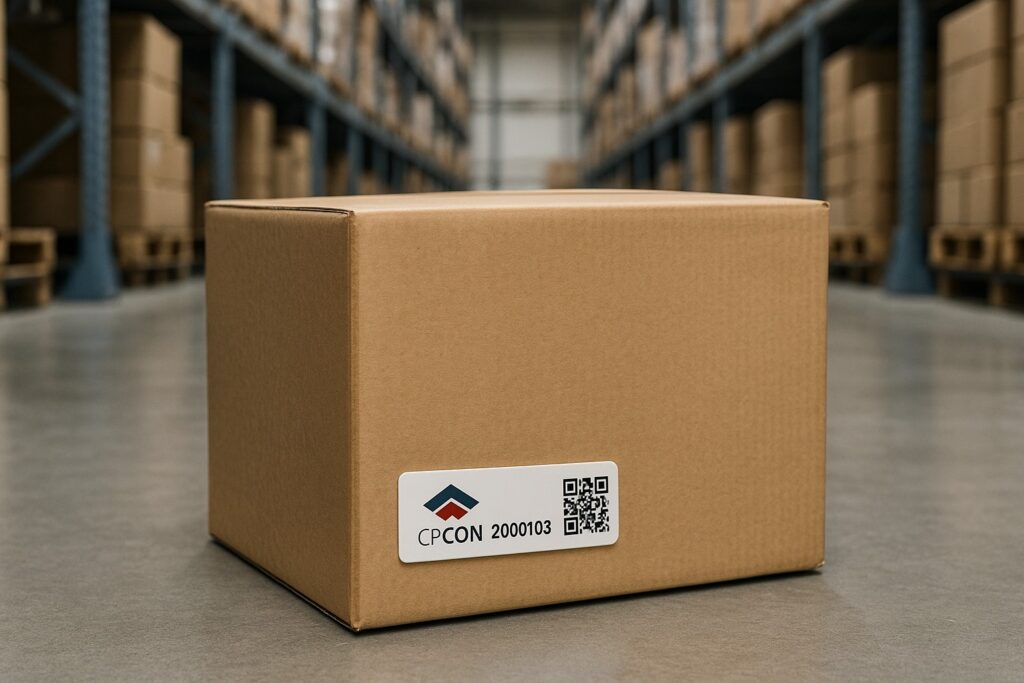Inventory stock is the process of counting, checking, and recording all items stored in a warehouse, distribution center, or production unit. It seems simple – but when it fails, the consequences can be enormous.
A recent case shocked the market: two employees at a Kia factory in India stole over 1,000 engines over three years. The scheme involved trucks with fake license plates, falsified invoices, and external help. The loss exceeded US$ 2.3 million, but what’s most striking is that the fraud was only discovered during a routine audit. No one noticed the missing engines before that. What was missing? Good inventory control.
Effective inventory management prevents losses and protects a company’s results. In busy environments, having a reliable counting and tracking process is essential to maintain control and avoid vulnerability.
In this article, you will understand:
- What inventory stock is, explained simply.
- Why it’s crucial for your business’s financial health.
- What signs indicate something might be wrong.
- And how good practices – like cycle counts and the use of RFID – can transform your internal control into a competitive advantage.
Let’s get straight to the point. Because losing control can be too costly.
Table of Contents
ToggleWhat is Inventory Stock?
Inventory stock is the process of checking, counting, and recording everything a company has stored – from materials used to make something to finished products. It’s like taking an exact picture of your warehouse to know, for sure, what’s actually there.
There are different ways to do this: it can be done manually, using lists; automatically, with computer systems; or with the help of technologies like RFID, which identify items by radio, without needing to open boxes.
But, regardless of the method, the goal is the same: to ensure that what’s recorded in the system is exactly what physically exists in stock.
Stocktaking is also essential for answering basic questions that don’t always have easy answers:
- How many items do we truly have available for delivery?
- Are there expired or long-stalled products?
- Why is there a discrepancy between the system and the physical count?
- Was any movement made without being recorded?
When these questions linger, the company starts operating in the dark. And this “darkness” can hide financial losses, internal theft, and even failures in customer service.
Furthermore, inventory stock serves as the basis for important decisions: merchandise replenishment, purchasing management, turnover analysis, and even tax and financial audits. Without it, planning becomes guesswork. And guesswork, in the business world, is expensive.
Listing isn’t just about counting boxes. It’s about creating visibility. It’s about transforming stock into reliable information — and reliable information is the first step to making decisions with confidence.

Why Is Inventory Stock So Important? Preventing Losses and Gaining Control
You might be thinking, “Why bother counting everything all the time?” The truth is, a strong inventory stock process is much more than just counting items. It’s about protecting your business from hidden problems and giving you real control. Without it, you’re flying blind, and that can lead to big trouble.
Think about it: if you don’t really know what’s in your warehouse, how can you promise a delivery date to a customer? How do you know when to order more of a popular product, or stop ordering something that just sits there? Missing this crucial visibility can lead to lost sales, frustrated customers, and wasted money.
Beyond daily operations, a reliable inventory stock system acts like a shield. It helps you quickly spot issues like products going missing, items expiring, or even internal theft. Remember the Kia factory example? Over a thousand engines disappeared, costing millions, simply because their inventory control wasn’t good enough to catch the ongoing fraud. That’s a huge lesson in why accurate counts and constant vigilance are non-negotiable.
Ultimately, robust inventory stock management isn’t just about avoiding problems; it’s about gaining a clear picture of your assets. This clarity empowers you to make smarter decisions, optimize your spending, and ensure your company’s financial health remains strong. It’s the foundation for efficient operations and a secure future.
Kia Case: When Lack of Inventory Costs Millions
The story of the Kia factory in India is a stark reminder of what can happen when inventory control isn’t taken seriously. For three long years, two employees managed to steal over 1,000 engines, racking up a loss of US$ 2.3 million.
What’s truly shocking is that this massive fraud went unnoticed until a routine audit finally brought it to light. Imagine: over a thousand engines, which certainly don’t fit in a pocket, simply vanished without anyone realizing.
This wasn’t a case of a single, quick theft. It was an ongoing operation involving fake invoices, altered license plates, and external collaborators, moving engines across thousands of kilometers to be sold on the black market.
The fact that the factory management only discovered this huge discrepancy during a fiscal year audit highlights a critical failure in their inventory stock processes. It shows how even in large-scale operations with high volumes of materials, a lack of continuous and reliable checking can lead to significant financial bleeding and reputational damage.
The Kia incident serves as a powerful lesson: neglecting inventory accuracy doesn’t just mean a few missing parts. It opens the door to massive financial losses, compromises the security of your assets, and damages stakeholder trust.
It underscores why a robust and frequent inventory stock system is not just good practice, but an absolute necessity for survival in a competitive market.
What’s the Difference Between “Stock” and “Inventory”?
It’s common to hear the terms “stock” and “inventory” used interchangeably, and in many contexts, they refer to the same thing: the goods a company has on hand. However, for those looking to be precise and understand the nuances of supply chain management, there’s a subtle but important distinction, especially in a professional setting.
Stock generally refers to the goods and materials a company keeps on hand for future use or sale. It’s the physical collection of items. For example, a retailer has a stock of clothes, a car manufacturer has a stock of tires, and a restaurant has a stock of ingredients. It’s the “stuff” you possess.
Inventory, on the other hand, is the process of counting, valuing, and managing that “stock.” While “stock” is the noun referring to the items themselves, “inventory” is often used as a verb (to “inventory” items) or as a noun referring to the detailed list or accounting of those items. So, you have a stock of products, and you perform an inventory to verify and record that stock. Think of it this way: your shelves hold your stock, and the act of checking everything on those shelves is your inventory process.
In essence:
- Stock: The items themselves (the goods).
- Inventory: The process of managing, counting, and detailing those items, or the resulting record of what you have.
Understanding this difference helps clarify communication and ensures that when you talk about inventory stock, you’re focusing on both the physical goods and the critical management processes around them.

How to Conduct an Efficient Inventory Stock Count? Methods and Technologies
Now that we know why inventory stock is so vital, let’s look at how to actually do it well. An efficient process isn’t just about counting; it’s about accuracy, speed, and continuous improvement. There are several methods and technologies that can help you achieve this.
Manual Counting with Spreadsheets
This is the most basic method. You physically count items and record them on paper or in a spreadsheet. It’s affordable for small businesses, but it’s prone to human error and can be very time-consuming, especially with a large stock. It lacks visibility in real-time.
Automated Systems (Software)
Many companies use dedicated inventory management systems. These software solutions help you track items as they move, from receiving to shipping. They reduce manual errors, provide better data visibility, and can automate calculations. This leads to more precise inventory stock records.
Advanced Technologies (RFID, Barcodes)
For even greater efficiency and tracking, technologies like RFID (Radio-Frequency Identification) and advanced barcode scanning are game-changers.
- Barcodes: Scanning barcodes is much faster and more accurate than manual entry. It helps in precise tracking of items and reduces miscounts.
- RFID: This is like a “magic eye” for your stock. RFID tags send signals that can be read without needing a direct line of sight or even opening boxes. This drastically speeds up counting, improves accuracy, and offers real-time visibility of your inventory stock, making discrepancy detection much faster.
Choosing the right method or combination depends on your business size, budget, and the volume of items you handle. The key is to find a solution that supports continuous inventory control and provides reliable stock data.
Types of Inventory: Which is Best for Your Operation?
Not all inventory stock counts are created equal. Different business needs call for different approaches. Understanding the various types helps you pick the most effective strategy for your operations, ensuring better inventory accuracy and control.
- Physical Inventory (Full Count): This is the most comprehensive type. You stop all operations and count every single item in your stock. It’s done periodically (e.g., once a year) to get a complete and accurate picture. While it offers high accuracy, it’s disruptive and labor-intensive. It’s often used for auditing and to reconcile major discrepancies.
- Cycle Counting (Rotational Inventory): Instead of counting everything at once, cycle counting involves counting a small portion of your stock regularly (e.g., daily, weekly). You might focus on high-value items, fast-moving items, or problem areas. This method is less disruptive, helps maintain ongoing inventory accuracy, and allows you to catch errors quickly. It’s a great way to embed continuous inventory control into your daily routine.
- Spot Checks: These are quick, informal counts of a specific item or small area to verify quantities on the fly. They’re useful for quick problem-solving or checking specific concerns without a full inventory process.
The best type of inventory depends on factors like your business size, the value of your stock, the frequency of item movement, and your existing inventory management system. Many companies use a combination, relying on cycle counting for daily control and a full physical inventory less frequently for major reconciliation.
The Right Stock Level: The Great Dilemma
Finding the appropriate stock or inventory level is one of the biggest challenges in inventory management. Too much stock, and you tie up capital, pay for extra storage, and risk obsolescence. Too little, and you face lost sales, unhappy customers, and disrupted production. This is the “great dilemma” of inventory stock.
The goal is to balance these risks, ensuring you have enough stock to meet customer demand without accumulating excessive amounts. This balance contributes directly to your financial health.
Factors influencing the ideal stock level include:
- Demand Forecasting: How well you can predict what customers will buy.
- Lead Times: How long it takes for suppliers to deliver new stock.
- Supply Chain Reliability: How consistent your suppliers are.
- Storage Costs: The expense of holding stock.
- Product Shelf Life: How quickly items expire or become outdated.
Achieving the right level requires continuous monitoring and analysis. This is where a robust inventory management system truly shines, providing the data visibility needed to make informed decisions about purchasing and replenishment. It helps prevent both costly overstocking and damaging stockouts, contributing to overall efficiency.

Inventory Stock: An Investment in Your Company’s Security and Results
As we’ve seen, inventory stock is far more than just a routine accounting task. It’s a critical investment in your company’s security, financial health, and overall success. Neglecting it can lead to devastating consequences, as the Kia case vividly demonstrated. That multi-million dollar loss was a direct result of inadequate inventory control and a lack of discrepancy detection.
By implementing consistent and accurate inventory stock processes, you gain:
- Loss Prevention: You can identify and stop issues like theft, damage, and obsolescence before they become major problems. This directly protects your asset security and financial results.
- Operational Efficiency: Knowing exactly what you have prevents delays in production or shipping, optimizes purchasing, and improves customer service. This contributes to better supply chain management.
- Informed Decision-Making: Reliable inventory data empowers better planning for sales, marketing, and budgeting. It moves you from guesswork to strategic action.
- Compliance and Auditing: Accurate inventory records are essential for financial audits and tax compliance, building trust with stakeholders.
Investing in a robust inventory stock system – whether it’s through regular cycle counts, advanced technology, or a dedicated inventory management system – means investing in a resilient, transparent, and profitable business. It transforms your warehouse from a potential liability into a strategic asset, ensuring that your company’s future is secure and prosperous.
Explore more insights on inventory accuracy and asset protection:
● Fixed Asset Audit: Checklist with 5 practical steps to prepare yourself
● Mastering Fixed Asset Depreciation for Financial Accuracy
● Inventory Management: The Hidden Cost of the 6.5% Inventory Gap
How CPCON Group Delivers Smart Inventory Stock Solutions
If you’re looking for a way to avoid inventory failures like the Kia case — and instead turn your stock management into a strategic advantage — CPCON Group is here to help.
We go far beyond basic counting. Our solutions are built to give your business total control, real-time visibility, and protection against loss or fraud. Whether you’re a logistics manager, CFO, or operations leader, we work side-by-side with your team to ensure precision, efficiency, and peace of mind.
Here’s what CPCON Group can do for you:
- Professional inventory stock services, using proven methods and certified processes.
- Real-time tracking with RFID and barcode technology, improving speed, accuracy, and traceability.
- Customizable reports, ready for internal audits, compliance reviews, and strategic planning.
- Support for large and complex operations, including multiple warehouses and high-value items.
- Ongoing consulting, helping you create a sustainable inventory management process, not just a one-time count.
We don’t just count items — we help you see what others miss. From hidden losses to operational gaps, CPCON Group gives you the tools and insights to make better decisions and grow safely.
Ready to bring control back to your inventory?
Contact us today and discover how smart inventory solutions can protect your business and boost performance.
FAQ
What is the difference between inventory and stock?
Stock refers to the physical goods you have. Inventory is the process of checking, managing, and recording those goods — or the resulting list from that process.
How often should I do an inventory stock count?
It depends on your business. Some companies do full counts annually and cycle counts weekly or monthly. The more frequent the control, the lower the risk of loss.
What industries benefit most from inventory stock services?
Retail, manufacturing, logistics, healthcare, and energy — especially companies with high-volume warehouses, multiple sites, or valuable items.
How does RFID improve inventory accuracy?
RFID allows you to scan and track items remotely, without line of sight. It speeds up counts, detects discrepancies faster, and reduces human error.
Why choose CPCON Group for inventory stock control?
Because we combine experience, advanced technology, and tailored consulting to give you reliable, audit-ready results that protect your business from risk.























